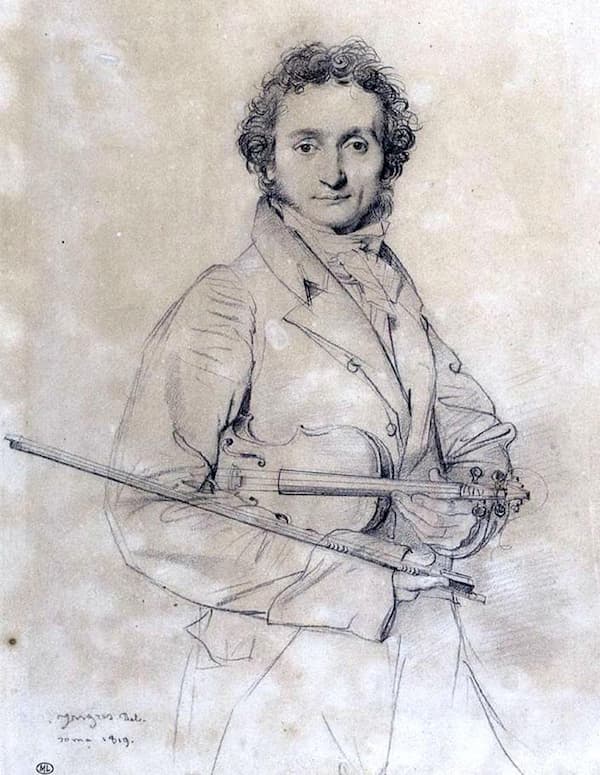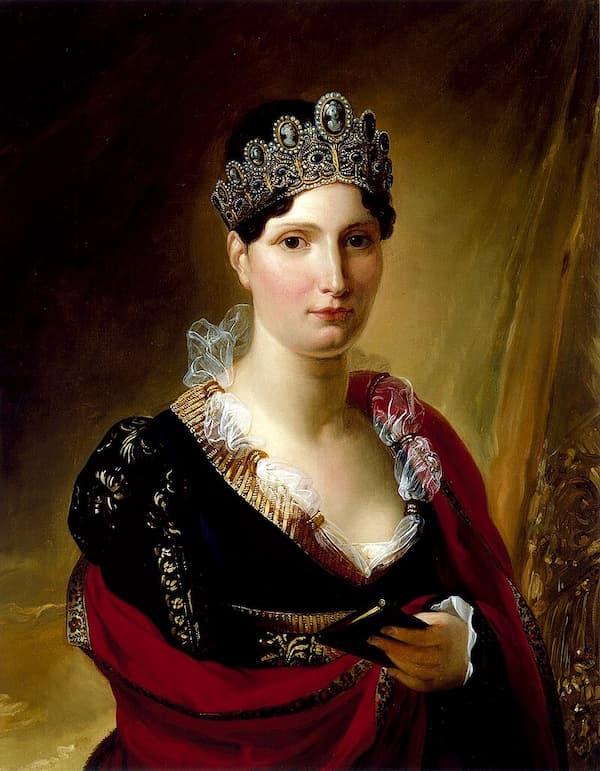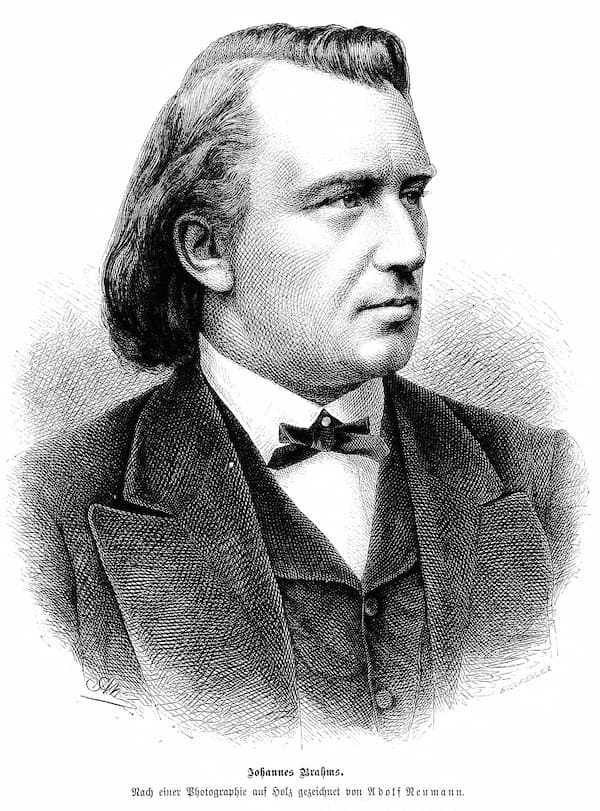The demon violinist, Niccoló Paganini (1782–1840), the most celebrated violin virtuoso of his day and who is still known today, wrote a set of 24 caprices for solo violin between 1802 and 1817.

Ingres: Niccolò Paganini, 1819 (Paris: Louvre)
The caprices (meaning ‘a sudden and unaccountable change of mood or behaviour’) were actually virtuosic etudes, with each caprice focusing on different techniques: arpeggios, string crossings, trills, double-stopping, and so on. The final caprice, no. 24, is a theme and variations movement but with some of the most difficult technical demands of the entire work, including very fast scales and arpeggios, double and triple stops, left hand pizzicato, parallel octaves and tenths, rapid shifting, and string crossings.
Niccoló Paganini: 24 Caprices, Op. 1 – No. 24 in A Minor: Tema quasi presto – 11 Variations – Finale (Ruggiero Ricci, violin)
This recording by Ruggiero Ricci is a nod to the man who, in 1947, was the first to record the 24 Caprices in their original setting for solo violin.
Paganini’s violin skills were recognised from an early age. His first instrument was the mandolin at age 5 and by 7 he had moved to the violin. He quickly outgrew the local violin teachers in Genoa and his father took him to Parma to study with Alessandro Rolla (1757–1841). Rolla immediately referred him to his own teacher Ferdinando Paer (1771–1839), and eventually, Paer referred him to his teacher, Gasparo Ghiretti (1747–1797). Thus, Paganini went from studying with someone who was slightly older than he was to someone from a generation and a half earlier. Ghiretti was considered a master teacher with a number of famous students to his credit.
By 1801, Paganini was appointed first violin of the Republic of Lucca, and had mastered the guitar, an instrument that he often wrote for. As the 18-year-old first violinist, his musical career was matched by his reputation in gambling and philandering. In 1805, Lucca became part of France and was made into a monarchy by Napoleon, who appointed his sister Elisa Bonaparte Baciocchi as ‘Princess of Lucca’.

Joseph Franque: Elisa Bonaparte Baciocchi, 1812
Paganini became violinist at the Baciocchi court and gave lessons to Elisa’s husband, Felice, for a decade while carrying on with Elisa. When the court moved from Lucca to Florence, Paganini accompanied them at first, but by 1809, left to resume his freelance career. A constant touring schedule combined with an extravagant lifestyle eventually took its toll and his health declined for the last decade of his life.
Paganini’s reputation as a demon violinist came from his grandstanding techniques, such as continuing to play difficult pieces as, one-by-one, the strings on his violin break. He seems to have had very long fingers, which gave him an extraordinary reach on this violin, enabling him to play notes and combinations others couldn’t reach. In the end, his continued push for technique changed the violin for the modern age. He wrote works that would amuse his listeners and works that would amaze them with their technical demands. He was the ultimate showman with the ultimate showstoppers.
His 24 Caprices have fascinated his followers, and those who didn’t play violin soon transcribed it for their own instruments. We will look at a number of different versions, starting with the most basic, adding other instruments to the violin, and then expanding to other sounds.
Himself a violin virtuoso, Fritz Kreisler (1875–1962), had a particular fondness for making arrangements of Paganini’s works. His own style was known for its extended use of vibrato not only for longer notes but on shorter ones as well. Kreisler took Schumann’s arrangements of the Paganini Caprices, where he added piano accompaniment, and then made his own arrangements. For the 24th Caprice, Kreisler ‘takes eight of Paganini’s original eleven variations, omitting the third, in octaves, and adding a fourth, in triple-stopping. Paganini’s fifth variation is omitted, and Kreisler’s fifth, Paganini’s sixth, with its double-stopped thirds and tenths, marked Andante con moto, leads to Kreisler’s sixth version of the material, in semiquaver triplet figuration. There follows Paganini’s study in left-hand pizzicato and a final version by Kreisler in artificial harmonics.
Niccoló Paganini: 24 Caprices, Op. 1 – No. 24 in A Minor (arr. F. Kreisler for violin and piano) (Philippe Quint, violin; Dmitriy Cogan, piano)
The Polish composer Karol Szymanowski made his own violin and piano arrangements of three of Paganini’s works, leaving the violin part alone but writing a distinctive piano part. Created in 1918, the work is a rethinking of Paganini’s original in light of WWI, adding ‘estranging, restless and unexpected harmonies and gloomy atmospheres of the piano part’.
Karol Szymanowski: 3 Paganini Caprices, Op. 40 – No. 3. Caprice No. 24 in A Minor (Francesca Bonaita, violin; Saskia Giorgini, piano)
Schumann’s arrangement for violin and piano was later expanded to become a version for violin and orchestra. Both Schumann and Liszt were attracted by Paganini’s work, and it is their interest that transferred Paganini’s work to inspire pianists. Violinists could do little to improve Paganini’s original, but the pianists could add a lot. In this recording, although nos. 1-23 are based on Schumann’s original arrangement in creating the orchestral score, the accompaniment for the last caprice comes from the guitar part written by Paganini and orchestrated here by Chris Nicols.
Niccoló Paganini: 24 Caprices, Op. 1 (arr. for violin and orchestra) – Caprice No. 24 in A Minor (Ruggiero Ricci, violin; Weiner Chamber Orchestra; Richard Weninger, cond.)
In arranging the work for string quartet, the ensemble is able ‘to make explicit the implicit harmonies and counterpoints contained within the writing…’. The arranger, William Zinn, makes the work less about the exploits of a single performer than about the notes and music that are implied by the writing.
Niccoló Paganini: 24 Caprices, Op. 1 (arr. W. Zinn) – No. 24 in A Minor: Tema con variazioni – Quasi presto (Wihan String Quartet)
We saw in his biography that Paganini was fond of the guitar, and, indeed, played it more in private settings than in public concerts. He described the guitar as his ‘constant companion’ on his concert tours in the late 18th century. This arrangement for violin and guitar preserves the two sides of Paganini’s musical mind.
Niccoló Paganini: 24 Caprices, Op. 1 – No. 24 in A Minor (Luigi Alberto Bianchi, violin; Maurizio Preda, guitar)
When we start looking at the arrangements for solo instruments, we can start with Paganini’s two other instruments: the mandolin and the guitar.
In this transcription for the mandolin, the performer can take advantage of the extremes of the instrument and the ability to play multiple notes at once.
Niccoló Paganini: 24 Caprices, Op. 1, MS 25 (arr. for mandolin) – No. 24 in A Minor: Tema quasi presto – 11 Variations – Finale (Dor Gidon Amran, mandolin)
Paganini was known to play both the violin and the guitar on the same piece, when in a small circle with friends. He would grip his violin between his knees and then pick up the guitar, to continue playing the same piece. Much of Paganini’s guitar writing shows that he thought of guitar music as linear, melodic, rather than chordal, in keeping with his playing of the violin.
Niccoló Paganini: 24 Caprices, Op. 1, MS 25 (arr. for guitar) (excerpts) – No. 24 in A Minor (Marco Tamayo, cond.)
It has been estimated that nearly every instrument has a version of the Caprices, including arrangements for viola, cello, double bass, flute, oboe, clarinet, horn, bassoon, trumpet, trombone, saxophone, euphonium, marimba, banjo, accordion, and harmonica, at the very least. We won’t look at all of these, but select a few that show the highlights (and perhaps the problems) with moving a distinctive voice from violin to other instruments.
A 1983 recording by Yo-Yo Ma captures both Paganini’s original ideas and the capabilities of the new star on the cello.
Niccoló Paganini: 24 Caprices, Op. 1 (arr. Y.-Y. Ma) – No. 24 in A Minor: Tema quasi presto – 11 Variations – Finale (Yo-Yo Ma, cello)
When performed on the clarinet, however, the technical demands seem to become a difficulty for the performer.
Niccoló Paganini: 24 Caprices, Op. 1, MS 25 – No. 24 in A Minor: Tema quasi presto – 11 Variations – Finale (arr. S. Korody-Kreutzer for clarinet) (Luigi Magistrelli, clarinet)
Alison Balsom’s sublime trumpet playing, on the other hand, without the help of piano, admirably brings the string work to the violin.
Niccoló Paganini: 24 Caprices, Op. 1 – No. 24 in A Minor (arr. J. Milone and A. Balsom) (Alison Balsom, trumpet)
The recorder player Francis Colpron made a transcription for his instrument, but in facing up to the problems of the original work, could make his own additions. He noted that some of the challenges included the fact that the violin had a larger range (in both directions) than the recorder, the violin could play 2 or 3 notes at a time where the recorder could not, and was also more versatile in playing broken chords and bariolage (the quick alternation between a repeated static note and the changing notes of a tune). On top of all that, the violin has a greater dynamic range, while the recorder is more monophonic. Nevertheless, by adding idiosyncratic recorder lines, Colpron is able to make the work his own.
Niccoló Paganini: 24 Caprices, Op. 1, MS 25 – No. 24 in A Minor (arr. F. Colpron for recorder) (Francis Colpron, recorder)
When moved to a percussion instrument, in this case the marimba, the performer is able to add subtlety in expression. The double and triple stopping of the original doesn’t affect the transcription.
Niccoló Paganini: 24 Caprices, Op. 1, MS 25 – No. 24 in A Minor: Tema quasi presto (arr. A. Ferrière for marimba) (Adélaïde Ferrière, marimba)
What happens if you remove the soloist entirely? In his orchestration of the Caprices, Ukrainian composer Myroslav Skoryk (1938–2020) worked for nearly 20 years on the arrangement. In his arrangement, Skoryk sought to make a work ‘where one could enjoy all the richness of timbres and emphasise the fullness of the harmonies’. It’s a very modern sound with its expanded use of percussion, and non-normal orchestral instruments, such as the banjo and the flexatone. Like Szymanowski before him, he didn’t change Paganini’s original writing but added modern percussion instruments and some jazz rhythms.
Niccoló Paganini: 24 Caprices, Op. 1 (arr. M. Skoryk for orchestra) – No. 24 in A Minor (Lviv International Symphony Orchestra; Alexander Zemtsov, cond.)
The percussive-fingerstyle guitarist Marcin (b. 2000) combines fingerstyle playing with percussive strikes on the guitar body and electronic production. The result is a thoroughly modern sound and reading of Paganini’s piece, without losing its virtuosic character.
Niccoló Paganini: 24 Caprices, Op. 1, MS 25 – No. 24 in A Minor: Tema quasi presto (arr. Marcin for guitar) (Marcin)
Benny Goodman, jazz clarinetist and promoter of modern music, made his own brief arrangement of the 24th Caprice, adding his own distinctive stylings.
Niccoló Paganini: 24 Caprices, Op. 1, MS 25 – No. 24 in A Minor (arr. B. Goodman for clarinet and piano) (Emma Johnson, clarinet; John Lenehan, piano)
All of these works are straight (or somewhat straight) transcriptions. Arrangers removed variations that wouldn’t work on the instrument or substituted their own version.
There’s a whole list of works that use the Caprices as the basis for entirely new compositions, starting with piano works such as Schumann’s Études after Paganini’s Caprices, Op. 3 (1832), and Six Concert Études after Paganini’s Caprices, Op. 10 (1833), Liszt’s Études d’exécution transcendante d’après Paganini (1838–40) and 6 grandes études de Paganini (1851) and Brahms’ Variations on a Theme by Paganini (1862–63). In the 20th century, we have yet more, now expanded to orchestral settings, including Rachmaninoff’s Rhapsody on a Theme of Paganini, Op. 43 (1934), for piano and orchestra, Lutosławski’s Variations on a Theme of Paganini (1941) for two pianos, and Boris Blacher’s Orchestral Variations on a Theme by N. Paganini, Op. 26 (1947), Philip Whilby’s Paganini Variations (1991), for brass band, Fazil Say’s Paganini Jazz: Variations on the Caprice No. 24 in the Style of Modern Jazz (1995), and Poul Ruders’ Paganini Variations (1999-2000) for guitar and orchestra. Even Andrew Lloyd-Weber made his Theme and Variations 1-4 (From Paganini’s Caprice in A Minor, No. 24 (1978), in a recording with Andrew Lloyd Webber on synthesiser, Rod Argent on keyboards, Julian Lloyd-Webber on cello, and Phil Collins on percussion, among many other performers.
Paganini, Lloyd Webber: Theme And Variations 1-4 (From Paganini’s Caprice in A Minor, No. 24)
To return to the original (and to reset your ears), here’s Augustin Hadelich playing the 24th Caprice in 2024.
Augustin Hadelich plays Paganini Caprice no. 24
For more of the best in classical music, sign up for our E-Newsletter


